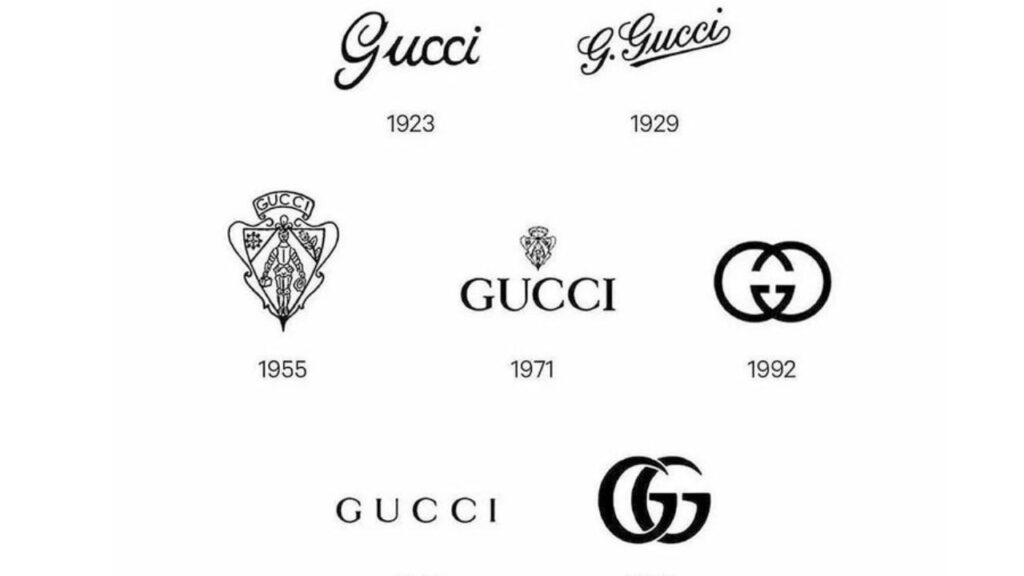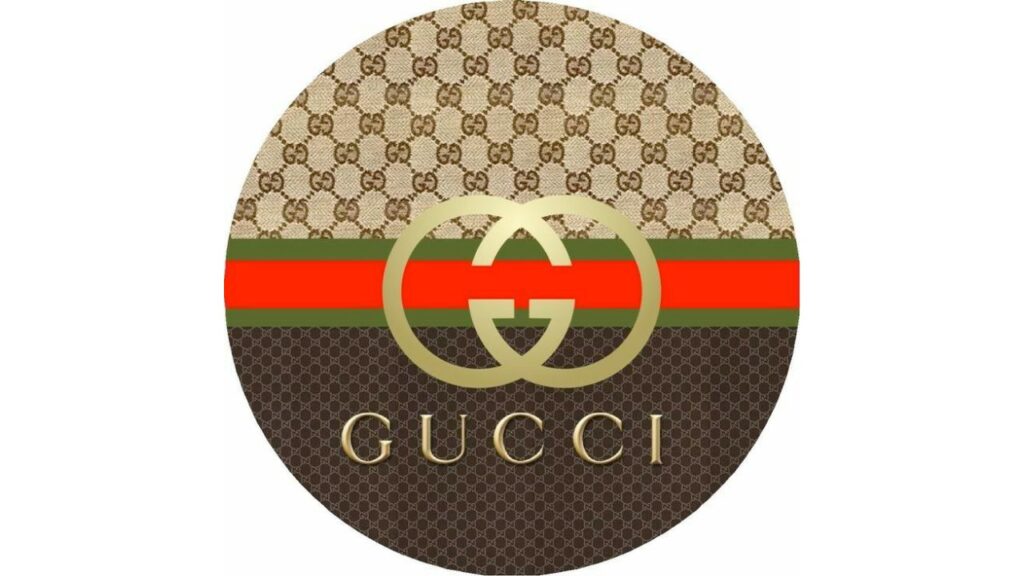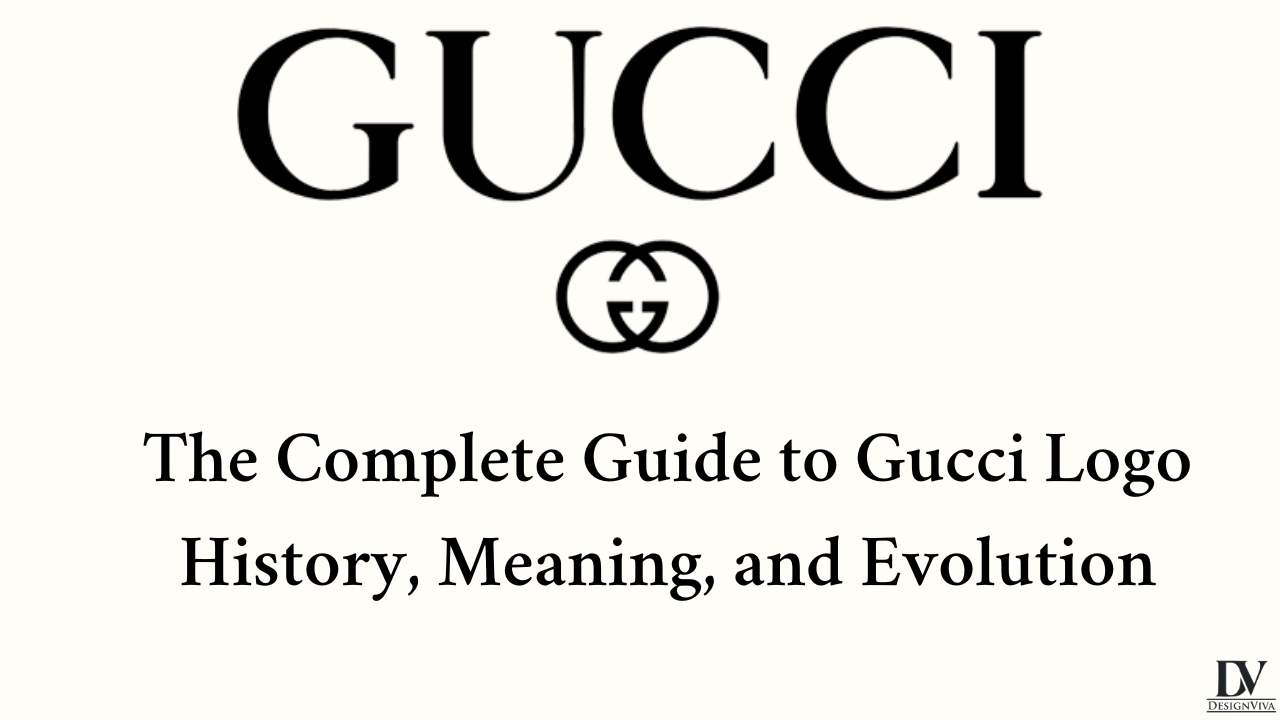A Brief History of the Gucci Logo

The Gucci logo is an emblem of excellence and high quality. It's a symbol of sophistication and luxury, as well as innovation. It has been a symbol of luxury and high-end fashion since its inception in 1921. Though the logo has gone through several iterations over the years, its core design remains unchanged. Over the years, the Gucci brand grew from a line of handmade leather luggage pieces to an iconic Italian fashion house that adorns the world’s most fashionable celebrities. Through his vision, he was able to create a brand that stands for timeless style and quality craftsmanship. Here we will explore how this vision was reflected in his choice of logo design and how it evolved over time.
The Gucci logo represents sophistication, luxury, and the very best Italian style. Here is a brief history of the Gucci logo:
The Origins (the 1920s-1950s): The Gucci brand was founded in 1921 by Guccio Gucci in Florence, Italy. The original Gucci logo featured a simple block text in uppercase letters with the words "Guccio Gucci" written in black, with the letter "G" slightly larger than the other letters. This logo was used on the brand's leather goods and luggage.
The Double G Logo (the 1960s-1970s): In the 1960s, Gucci introduced its iconic double G logo, also known as the "GG" logo. Designed by Aldo Gucci, one of Guccio Gucci's sons, the GG logo features two interlocking Gs in a symmetrical pattern, which became a symbol of the brand's luxury and sophistication. The double G logo was used on various products, including handbags, belts, and jewelry, and it became synonymous with the Gucci brand.
The Red and Green Stripe (1950s-1980s): Another iconic element of the Gucci logo is the red and green stripe, also known as the "Web." Inspired by horse racing, the stripe features two horizontal lines in red and one in green, with a thinner white line in between. This stripe was initially used on the brand's luggage and later became a signature design element used on various Gucci products, including handbags, clothing, and accessories.
The Evolution (the 1980s-2000s): In the 1980s, the Gucci logo underwent some changes. The double G logo was simplified, and the red and green stripe was used less prominently. The brand experimented with different color schemes and styles, including using the logo in gold, silver, and different patterns. In the 1990s and 2000s, the Gucci logo featured a clean and minimalistic design with bold, uppercase text in black or gold, often accompanied by the double G logo.
The Modern Logo (2010s-Present): In 2013, under the creative direction of Alessandro Michele, Gucci introduced a new logo that combined elements from its rich history. The modern Gucci logo features bold, uppercase text in black with a refined, simplified version of the double G logo in gold, placed above the text. The red and green stripe is still used but in a more subtle and minimalistic way. This logo has become the current representation of the Gucci brand and is widely used across its products and marketing materials.
Overall, the Gucci logo has evolved over the years while maintaining its iconic elements, such as the double G logo and the red and green stripe, which have become synonymous with the brand's luxury and sophistication. The logo has gone through different styles and designs, reflecting the changing trends and creative visions of the brand's creative directors, but it has always remained a recognizable symbol of Gucci's status as a leading luxury fashion house.
The Meaning Behind the Gucci Logo and Its Symbolic Representation

Gucci is one of the world's leading luxury goods companies, renowned for its exquisite Italian craftsmanship. Since 1921, it has hit the scene with iconic and trendsetting styles. Guccio Gucci, the founder of the brand, designed the GG monogram logo with two interlocking G's. This logo design has become a symbol of luxury and high-end fashion that stands out from other brands.
The GG monogram logo is more than just a statement of luxury - it has a deep symbolic meaning behind it. It represents Gucci's original vision of creating timeless beauty and elegance that stands out from all other brands. The interlocking G's also represent how two different worlds combine to create something beautiful – an idea that perfectly embodies Gucci's mission to bring together traditional craftsmanship and modern innovation.
The Gucci logo, with its double G logo and red and green stripe, carries several meanings and symbolic representations that are deeply rooted in the brand's history and heritage. Here are some key meanings behind the Gucci logo:
Luxury and Prestige: The Gucci logo is synonymous with luxury and prestige. The double G logo, designed by Aldo Gucci in the 1960s, is an iconic symbol of the brand's commitment to quality craftsmanship, sophistication, and exclusivity. It represents Gucci's status as a high-end fashion house and its reputation as a luxury brand that offers premium products for discerning customers.
Heritage and Tradition: The Gucci logo also reflects the brand's rich heritage and tradition. The brand was founded in 1921, and its logo has evolved over the years, incorporating various design elements that pay homage to its history. The red and green stripe, inspired by horse racing, is one such element that has been used in Gucci's logo and designs for decades, representing the brand's Italian roots and its connection to equestrian culture.
Timelessness and Endurance: The Gucci logo's enduring design and continued use over the years symbolize the brand's timelessness and endurance. Despite evolving styles and trends in the fashion industry, the Gucci logo has remained relevant and recognizable, showcasing the brand's ability to adapt while staying true to its core identity.
Fashion Forwardness and Innovation: While rooted in tradition, the Gucci logo also represents the brand's fashion forwardness and innovation. In recent years, under the creative direction of Alessandro Michele, the brand has taken a bold and eclectic approach to its designs, including the logo. The modern Gucci logo, introduced in 2013, reflects a contemporary aesthetic with a sleek and minimalistic design, showcasing the brand's ability to stay relevant and push boundaries in the ever-evolving fashion industry.
Brand Recognition and Identity: The Gucci logo is a powerful symbol of brand recognition and identity. It is instantly recognizable and carries a strong association with Gucci's products and reputation. The logo serves as a visual cue for consumers, communicating the brand's values, quality, and authenticity, and helping to establish a strong brand identity in the competitive luxury fashion market.
In summary, the Gucci logo carries several meanings and symbolic representations, including luxury, heritage, timelessness, fashion forwardness, and brand recognition. It reflects the brand's history, tradition, and innovation while serving as a visual symbol of Gucci's prestigious identity in the fashion industry.
How Has the Gucci Logo Evolved Over Time And What Does This Represent?
Gucci is a legendary fashion house whose iconic logo has remained unchanged over the years. It’s instantly recognizable and evokes an image of luxury, style, and sophistication. But what few people know is that the Gucci logo has actually evolved over time to reflect the brand’s changing identity.
From the original “GG” monogram to today’s contemporary interlocking “G's” logo, Gucci has sought to ensure its presence in fashion history. In this article, we will explore the changes in the iconic Gucci logo and discover what they represent for this Italian fashion powerhouse.
The Gucci logo has evolved over time, reflecting the brand's changing creative visions, design trends, and market demands. Here are some notable changes in the Gucci logo's evolution and what they represent:
Introduction of the Double G Logo (the 1960s): One of the most significant changes in the Gucci logo's history was the introduction of the iconic Double G logo in the 1960s. Designed by Aldo Gucci, one of Guccio Gucci's sons, the double G logo features two interlocking Gs in a symmetrical pattern, creating a sleek and recognizable design. This change represented a new era for the brand, showcasing its commitment to innovation and modernity while maintaining its luxury and sophistication.
Simplification of the Double G Logo (the 1980s): In the 1980s, the Gucci logo underwent a simplification process, where the double G logo was streamlined and made more minimalist. The original double G logo with intricate details was replaced with a cleaner and more straightforward version, featuring a bolder and more geometric design. This change reflected the design trends of the time, with a shift towards minimalism and simplicity, while still preserving the brand's iconic double G logo.
Minimalistic Approach (the 1990s-2000s): In the 1990s and 2000s, the Gucci logo featured a minimalistic approach with bold, uppercase text in black or gold, often accompanied by the double G logo. The logo had a cleaner and more contemporary look, reflecting the design sensibilities of the time and catering to the demand for sleek and modern aesthetics. This change represented Gucci's ability to adapt to evolving design trends while maintaining its luxury and fashion-forward identity.
Reinterpretation of the Logo (the 2010s): In 2013, under the creative direction of Alessandro Michele, Gucci introduced a new logo that reinterpreted its iconic elements. The modern Gucci logo features bold, uppercase text in black with a simplified version of the double G logo in gold, placed above the text. The red and green stripe, another iconic element of the brand, is still used but in a more subtle and minimalistic way. This change represented a bold and innovative approach to the logo, showcasing the brand's willingness to experiment with design elements and create a fresh and contemporary look.
Playfulness and Eclecticism (Current): In recent years, the Gucci logo has embraced a more playful and eclectic approach under Alessandro Michele's creative direction. The logo has been used in a variety of colors, patterns, and styles, reflecting the brand's bold and avant-garde designs. This change represents Gucci's willingness to break traditional design norms, push boundaries, and cater to a younger and more fashion-forward audience.
In summary, the evolution of the Gucci logo over time represents the brand's ability to adapt to changing design trends, market demands, and creative visions while maintaining its luxury, prestige, and brand identity. It showcases Gucci's commitment to innovation, modernity, and fashion-forwardness while preserving its heritage and iconic elements that have made it one of the most recognized luxury fashion brands in the world.
Exploring Popular Alternatives To The Classic Interlocking G's Design
For over a century, the Interlocking G's design has been an iconic symbol of quality and sophistication. But in recent years, there have been more and more contemporary variations of the GG monogram design. In this article, we will explore some of the most popular alternatives to this classic design. From intertwined letters to abstract shapes and patterns, these designs all offer something unique while still maintaining the essence of the original Interlocking G's. We'll also look at their use cases in various industries and explore what makes them so appealing to consumers today.
While the iconic interlocking G's design is the most recognized and widely used logo for Gucci, the brand has also experimented with alternative designs over the years. Here are some popular alternatives to the classic interlocking G's design that Gucci has explored:
Gucci Bee: The Gucci Bee is a whimsical and playful design that features a bee motif with colorful wings and a striped body. It has been used in various forms, including on clothing, accessories, and home decor items. The Gucci Bee represents nature, vitality, and creativity, adding a touch of whimsy and eclecticism to Gucci's designs.
Gucci Tiger: The Gucci Tiger is a fierce and powerful design that showcases a tiger's face with intricate details, such as embroidered or printed patterns. The tiger is a symbol of strength, courage, and vitality, and adds a bold and statement-making element to Gucci's designs, representing a sense of fearlessness and boldness.
Gucci Snake: The Gucci Snake is a symbolic design that features a snake motif with its sinuous body and detailed patterns. The snake is a symbol of transformation, rebirth, and wisdom, and is often associated with Gucci's creative and avant-garde designs. The Gucci Snake adds a mystical and symbolic touch to Gucci's creations, representing a sense of intrigue and mystery.
Gucci Floral Motifs: Gucci has also experimented with various floral motifs in its designs, such as roses, daisies, and peonies. These floral motifs represent beauty, femininity, and romance, adding a soft and delicate touch to Gucci's designs. Floral motifs have been used in different forms, including prints, embroideries, and appliqués, adding a touch of nature and elegance to Gucci's creations.
Gucci Stars: The Gucci Stars is a celestial design that features stars in various forms, such as embroidered, printed, or embellished. Stars represent aspiration, dreams, and inspiration, and add a touch of cosmic and mystical allure to Gucci's designs. The Gucci Stars represent a sense of wonder and magic, adding a touch of whimsy and enchantment to Gucci's creations.
These are some popular alternatives to the classic interlocking G's design that Gucci has explored over the years, showcasing the brand's creativity, innovation, and willingness to experiment with different design elements while maintaining its luxury and fashion-forward identity.
Conclusion: Celebrate The Iconic & Enduring Legacy Of The Gucci Logo
The iconic Gucci logo is a symbol of elegance and sophistication that has been embraced by luxury fashion brands around the world. It is one of the most recognizable and enduring fashion brand logos in history, having been in existence for over a hundred years.
This iconic logo has become synonymous with quality and style, making it an integral part of the Gucci brand. In this article, we will take a look at the history and evolution of this iconic logo, as well as its impact on modern fashion trends. We will also explore how other luxury fashion brands have adopted or adapted the Gucci logo to create their own unique visual identity. Finally, we’ll celebrate the iconic and enduring legacy of the Gucci logo that continues to inspire generations of fashion designers today.
The Gucci logo has a rich history, with its iconic interlocking G's design representing the brand's heritage, luxury, and fashion-forward identity. Over the years, the Gucci logo has evolved, adapting to changing fashion trends and consumer preferences, while still maintaining its distinctive aesthetic.
The interlocking G's design has become synonymous with Gucci, symbolizing the brand's commitment to quality, craftsmanship, and innovation. It has adorned various Gucci products, including clothing, accessories, and home decor items, and has been recognized as a symbol of luxury and style.
In addition to the classic interlocking G's design, Gucci has also explored alternative designs, such as the Gucci Bee, Gucci Tiger, Gucci Snake, floral motifs, and stars, adding unique and symbolic elements to its creations. These alternative designs represent Gucci's creativity, whimsy, and willingness to push boundaries in the world of fashion.
The Gucci logo has stood the test of time, remaining relevant and iconic in the ever-changing landscape of fashion. It continues to be celebrated by fashion enthusiasts, celebrities, and consumers alike, as a symbol of luxury, elegance, and innovation.
As Gucci continues to evolve and innovate, its logo will likely continue to play a pivotal role in its brand identity, representing its enduring legacy as one of the world's most renowned and respected luxury fashion houses.





